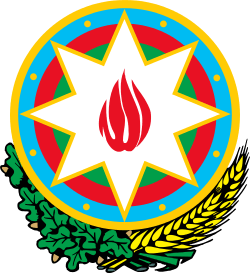Dashkasan District
| Daşkəsən | |
|---|---|
| Rayon | |
.svg.png) Map of Azerbaijan showing Dashkasan rayon | |
| Coordinates: 40°31′05″N 46°04′58″E / 40.51806°N 46.08278°ECoordinates: 40°31′05″N 46°04′58″E / 40.51806°N 46.08278°E | |
| Country | Azerbaijan |
| Capital | Daşkəsən |
| Area | |
| • Total | 1,047 km2 (404 sq mi) |
| Population (2010)[1] | |
| • Total | 32,900 |
| Postal code | 1600 |
| Telephone code | (+994) 22[2] |
Dashkasan (Azerbaijani: Daşkəsən) is a rayon of Azerbaijan. The district was called Dastafur (Azerbaijani: Dəstəfur) until 1956.
The district is located in northwestern Azerbaijan, 33–41 km away from Ganja city and on northeastern edge of Lesser Caucasus rising 1,600-1,800 meters above sea level. The regional capital of the raion is Dashkasan city located by Qoshqar River on a mountain. The capital was established as an urban facility on March 16, 1948, after the end of World War I, mainly to explore and mine iron ore and other natural resources.[3]
Administrative divisions
The rayon itself was founded as an administrative center in 1930 and was named Dastafur until 1956 when it was renamed to Dashkasan. In 1963, the rayon status was eliminated and Dashkasan province was merged with Khanlar Rayon. However, in 1965, it was split again and Dashkasan regained its administrative rayon status. There is one city, six city type settlements and 42 villages in Dahskasan Rayon. Dashkasan rayon shares an 8 km border with Armenia and 24.5 km border with Shamkir Rayon, 23 km border with Kalbajar Rayon, 41 km border with Gadabay Rayon, 56.3 km border with Khanlar Rayon.[3]
Demographics
Ethnic Groups
Population 30,510[4]
Religion
- Muslim 99,8%
- Other 0,2%
Language
- Azerbaijani Language 100%
Nature
The rayon covers the Dashkasan plateau of the Lesser Caucasian Mountain range encompassing parts and tips of Shahdagh and Murovdag ranges. The highest altitudes are at Hinaldag Peak (3,367 meters) and Qoshqar Peak (3,361 meters). Part of Bashkend-Dastafur lowlands also falls in Dashkasan rayon. This part of the region is rich with cretaceous chalk. Average annual rainfall is 600–900 mm. It mostly rains during spring time. The mountains are enriched with oak forests.[3]
There is a lot of vegetation used for curing various deceases. Among the treating plants, one can find thyme, achillea, asteraceae, stellaria, mountain viola, etc.[3]
There are also so-called treatment springs containing pure mountain water which cleanse the internal organs.
- Yumurtalı spring - Qabaqtəpə village;
- Narzan spring - Yuxarı Daşkəsən settlement;
- Turşsu spring - Alaxançallı village;
- Qiblə spring - Qabaqtəpə kəndi;
- Qayğı spring - Qabaqtəpə kəndi;
- Böyrək spring - Alunitdağ settlement;
- İdris spring - Əmirvar village;
- Seyid spring - Xoşbulaq village.[3]
In Dashkasan rayon, the animal habitat is rich with roe deer, gazelle, deer, Caucasian goat, rabbit, marten, hedgehog, badger, wild bear, lynx, wolf, bear, fox, jackal.[3]
Natural resources
Starting from Soviet times, the region was one of the strategic centers for mining iron ore, aluminum, cobalt, marble. At the moment, gold, copper, cobalt, iron ore, marble are being mined.[3]
References
- ↑ The state statistical committee of the Azerbaijan Republic
- ↑ "Şəhərlərarası telefon kodları". Aztelekom MMC. Aztelekom İB. Retrieved 19 August 2015. (Azerbaijani)
- 1 2 3 4 5 6 7 "Dashkasan Executive Power". Retrieved 2010-07-26.
- ↑ Census table for Azerbaijani cities
External links
| Part of the series on |
| Azerbaijan Azərbaycan |
|---|
  |
| Culture |
| History |
| Demographics |
| Geography |
| Administrative divisions |
| Azerbaijan portal |